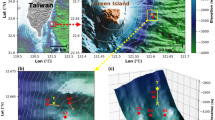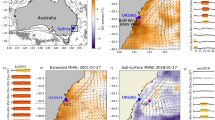Abstract
ENERGY dissipation due to deep-water wave breaking plays a critical role in the development and evolution of the ocean surface wave field. Furthermore, the energy lost by the wave field via the breaking process is a source for turbulent mixing and air entrainment, which enhance air–sea heat and gas transfer1–3. But the current lack of reliable methods for measuring energy dissipation associated with wave breaking inhibits the quantitative study of processes occurring at ocean surfaces, and represents a major impediment to the improvement of global wave-prediction models4. Here we present a method for remotely quantifying wave-breaking dynamics which uses an infrared imager to measure the temperature changes associated with the disruption and recovery of the surface thermal boundary layer (skin layer). Although our present results focus on quantifying energy dissipation—in particular, we show that the recovery rate of the skin layer in the wakes of breaking waves is correlated with the energy dissipation rate—future applications of this technique should help to elucidate the nature of important small-scale surface processes contributing to air–sea heat5 and gas6 flux, and lead to a fuller understanding of general ocean–atmosphere interactions.
This is a preview of subscription content, access via your institution
Access options
Subscribe to this journal
Receive 51 print issues and online access
$199.00 per year
only $3.90 per issue
Buy this article
- Purchase on Springer Link
- Instant access to full article PDF
Prices may be subject to local taxes which are calculated during checkout
Similar content being viewed by others
References
Banner, M. L. & Peregrine, D. H. Annu. Rev. Fluid Mech. 25, 373–397 (1993).
Thorpe, S. A. Prog. Oceanogr. 35, 315–352 (1995).
Melville, W. K. Annu. Rev. Fluid Mech. 28, 279–321 (1996).
Komen, G. J. et al. Dynamics and Modelling of Ocean Waves (Cambridge Univ. Press, 1994).
Farmer, D. M. & Gemmrich, J. R. J. Phys. Oceangr. 26, 816–825 (1996).
Kitaigorodskii, S. A. J. Phys. Oceanogr. 14, 960–972 (1984).
Katsaros, K. B. Boundary-Layer Meteorol. 18, 107–127 (1980).
Robinson, I. S., Wells, N. C. & Charnock, H. Int. J. Remote Sens. 5, 19–45 (1984).
McAlister, E. D. & McLeish, W. J. Geophys. Res. 74, 3408–3414 (1969).
Wu, J. J. Phys. Oceanogr. 1, 284–286 (1971).
Hill, R. H. J. Phys. Oceanogr. 2, 190–198 (1972).
Ewing, G. & McAlister, E. D. Science 131, 1374–1376 (1960).
Jessup, A. T., Zappa, C. J., Hesany, V., Loewen, M. R. & Skafel, M. G. in Air-Water Gas Transfer (ed. Jähne, B. & Monahan, E. C.) 601–610 (AEON Verlag & Studio, Hanau, 1995).
Eisner, L., Bell, E. E., Young, J. & Oetjen, R. A. J. Opt. Soc. Am. 52, 201–209 (1962).
Phillips, O. M. J. Fluid Mech. 156, 505–531 (1985).
Ding, L. & Farmer, D. M. J. Phys. Oceanogr. 24, 1368–1387 (1994).
Duncan, J. H. Proc. R. Soc. Lond. A 377, 331–348 (1981).
Melville, W. K. J. Phys. Oceangr. 24, 2041–2049 (1994).
Thorpe, S. A. J. Phys. Oceanogr. 23, 2498–2502 (1993).
Chan, E. S. & Melville, W. K. Proc. R. Soc. Lond. A 417, 95–131 (1988).
Melville, W. K. & Rapp, R. J. Nature 317, 514–516 (1985).
Rapp, R. J. & Melville, W. K. Phil. Trans. R. Soc. Lond. A 331, 735–800 (1990).
Loewen, M. R. & Melville, W. K. J. Fluid Mech. 224, 601–623 (1991).
Katsaros, K. B., Liu, W. T., Businger, J. A. & Tillman, J. E. J. Fluid Mech. 83, 311–335 (1977).
Barren, E. J. Eos 76, 185–190 (1995).
Keeling, R. F. J. Mar. Res. 51, 237–271 (1993).
Jähne, B., Libner, P., Fischer, R., Billen, T. & Plate, E. J. Tellus 41B, 177–195 (1989).
Soloviev, A. V. & Schlüssel, P. J. Phys. Oceanogr. 24, 1339–1346 (1994).
Haußecker, H. & Jähne, B. in Air-Water Gas Transfer (eds Jähne, B. & Monahan, E. C.) 775–784 (AEON Verlag & Studio, Hanau, 1995).
Author information
Authors and Affiliations
Rights and permissions
About this article
Cite this article
Jessup, A., Zappa, C., Loewen, M. et al. Infrared remote sensing of breaking waves. Nature 385, 52–55 (1997). https://doi.org/10.1038/385052a0
Received:
Accepted:
Issue Date:
DOI: https://doi.org/10.1038/385052a0
This article is cited by
-
Pixel-level plasmonic microcavity infrared photodetector
Scientific Reports (2016)
-
The thermal signature of a submerged jet impacting normal to a free surface
Journal of Visualization (2016)
-
The effects of surfactants on spilling breaking waves
Nature (2003)
-
Variation in surface turbulence and the gas transfer velocity over a tidal cycle in a macro-tidal estuary
Estuaries (2003)
Comments
By submitting a comment you agree to abide by our Terms and Community Guidelines. If you find something abusive or that does not comply with our terms or guidelines please flag it as inappropriate.



